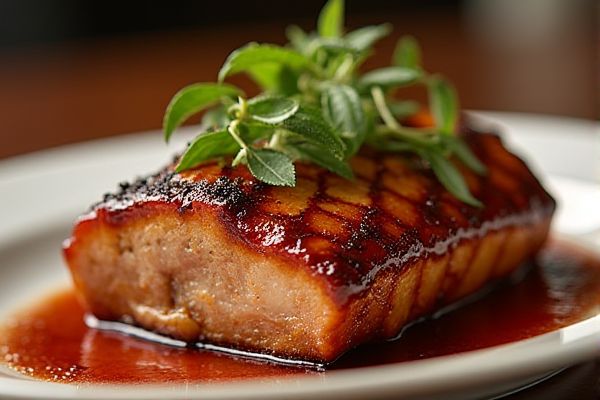
Seared Pork Belly from Fleming's Prime Steakhouse features tender, caramelized pork belly slices perfectly seared to a golden crisp, served with a rich, savory glaze and garnished with fresh herbs, delivering a succulent blend of crispy exterior and melt-in-your-mouth interior.
Equipments
- Chef's knife
- Cutting board
- Cast iron skillet or heavy-bottomed sauté pan
- Tongs
- Baking sheet
- Aluminum foil
- Small saucepan
- Whisk
- Basting brush
- Plate for serving
Ingredients
- 2 lbs (900g) pork belly
- Salt
- Black pepper
- 1 tablespoon vegetable oil
- 1/4 cup brown sugar
- 1/4 cup soy sauce
- 2 tablespoons honey
- 2 tablespoons rice vinegar
- 2 tablespoons unsalted butter
- 2 cloves garlic
- 1 teaspoon grated ginger
- 2 tablespoons water
- Fresh herbs (such as chives, parsley, or microgreens)
Make sure to select pork belly with a good balance of fat and meat for optimal tenderness and flavor. Fresh garlic and grated ginger are essential for authentic flavor in the glaze, while high-quality soy sauce enhances the savory richness. Use brown sugar and honey to achieve a perfect caramelized crust and glossy finish. Season the pork belly generously with salt and black pepper before searing to develop a golden crisp exterior. Your Seared Pork Belly from Fleming's Prime Steakhouse copycat will deliver a succulent blend of crispy exterior and melt-in-your-mouth interior, just like the original.
Instructions
- Preheat oven to 300°F (150°C).
- Pat pork belly dry with paper towels.
- Slice pork belly into even pieces.
- Season pork belly with salt and black pepper.
- Heat vegetable oil in a cast iron skillet over medium-high heat.
- Sear pork belly slices on all sides until golden brown and crispy.
- Transfer seared pork belly to a foil-lined baking sheet.
- Cover with foil and bake for 1.5–2 hours until tender.
- While baking, make glaze:
- Add brown sugar, soy sauce, honey, rice vinegar, butter, minced garlic, grated ginger, and water to a small saucepan.
- Whisk and simmer over medium heat until thickened (about 5–7 minutes).
- Remove pork belly from oven and uncover.
- Brush pork belly with the glaze using a basting brush.
- Return pork belly to oven uncovered; broil for 2–3 minutes to caramelize glaze.
- Plate pork belly slices.
- Drizzle with remaining glaze.
- Garnish with fresh herbs.
- Serve immediately.
Substitution
Seared Pork Belly from Fleming's Prime Steakhouse copycat menu delivers a perfect balance of crispy skin and tender meat enhanced by a savory glaze. If pork belly is unavailable, thick-cut pork shoulder or pork jowl can be a suitable alternative though the texture will differ slightly. Using a cast iron skillet is crucial for achieving the ideal sear, but a heavy-bottomed saute pan can substitute if necessary. When making the glaze, adjust sweetness and acidity to suit your taste by modifying the honey and rice vinegar proportions. Make sure to rest the pork belly slices after searing to lock in juices and maximize flavor for your dish.
Tips
Make sure to pat the pork belly completely dry before seasoning to achieve a perfect sear with a crispy crust. Use a cast iron skillet for even heat distribution and consistent caramelization. When glazing, watch closely to avoid burning the sugar, and use the broiler carefully to caramelize without overcooking. Your resting time after broiling ensures the pork belly stays juicy and flavorful.
Nutritions
Seared Pork Belly from Fleming's Prime Steakhouse provides a rich source of protein and essential fats, primarily from the pork belly itself, which is high in calories due to its fat content. The caramelized brown sugar and honey contribute simple sugars, while soy sauce adds sodium and trace minerals like iron. Ginger and garlic introduce antioxidants and anti-inflammatory compounds, enhancing nutritional value. Your meal balances indulgent flavors with nutrients that support energy and immune function.
Storage
Store leftover seared pork belly in an airtight container and refrigerate for up to 3 days to maintain its crisp texture and rich flavor. For longer storage, freeze the pork belly wrapped tightly in aluminum foil and placed in a freezer-safe bag or container for up to 2 months. When reheating, use a cast iron skillet or oven to restore the crispy exterior and avoid sogginess, ensuring your pork belly tastes as delicious as freshly cooked.
Variation or Alternatives
You can substitute pork belly with thick-cut pork shoulder for a leaner option that still provides rich flavor and tenderness. Instead of searing in vegetable oil, using rendered pork fat or duck fat can enhance the caramelization and add depth to the dish. For a smoky twist, try finishing the pork belly on a grill before glazing and broiling to infuse a subtle charred aroma. To elevate the glaze, incorporate a splash of bourbon or a pinch of Chinese five-spice powder to complement the sweetness and umami notes.
Allergies
The Seared Pork Belly contains soy sauce, which is a common allergen due to its soy content, and may pose a risk for individuals with soy allergies. The dish also includes garlic and ginger, which can cause sensitivities or allergic reactions in some people. If you have food allergies, it's important to check the ingredients carefully and inform the restaurant about your specific dietary restrictions.
Why this recipe?
Fleming's Prime Steakhouse's Seared Pork Belly is celebrated for its perfectly crispy exterior combined with tender, juicy meat, creating a rich and flavorful experience that appeals to pork enthusiasts. The dish often features a balance of savory and sweet elements, such as a caramelized glaze or accompanying fruit compote, enhancing its complexity and depth. Recreating this menu item at home allows you to master precise cooking techniques, such as searing and slow roasting, that elevate your culinary skills while enjoying a restaurant-quality dish. Your copycat version can deliver the same indulgent taste and texture, making it a rewarding and impressive addition to your dining repertoire.
